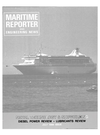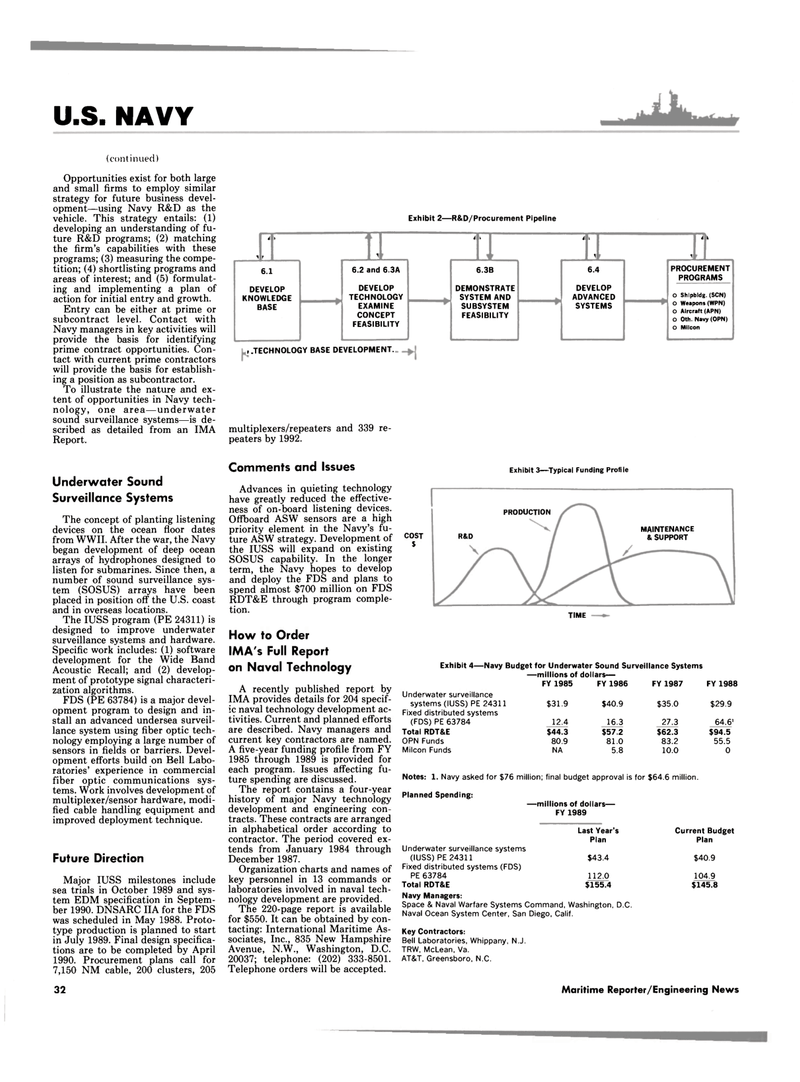
Page 24: of Maritime Reporter Magazine (July 1988)
Read this page in Pdf, Flash or Html5 edition of July 1988 Maritime Reporter Magazine
U.S. NAVY (continued)
Opportunities exist for both large and small firms to employ similar strategy for future business devel- opment—using Navy R&D as the vehicle. This strategy entails: (1) developing an understanding of fu- ture R&D programs; (2) matching the firm's capabilities with these programs; (3) measuring the compe- tition; (4) shortlisting programs and areas of interest; and (5) formulat- ing and implementing a plan of action for initial entry and growth.
Entry can be either at prime or subcontract level. Contact with
Navy managers in key activities will provide the basis for identifying prime contract opportunities. Con- tact with current prime contractors will provide the basis for establish- ing a position as subcontractor.
To illustrate the nature and ex- tent of opportunities in Navy tech- nology, one area—underwater sound surveillance systems—is de- scribed as detailed from an IMA
Report.
Exhibit 2—R&D/Procurement Pipeline 4 > i > t L "J k 1 r 1 1 \ 6.1 6.2 and 6.3A 6.3B 6.4 PROCUREMENT PROGRAMS
DEVELOP
KNOWLEDGE
DEVELOP
TECHNOLOGY
DEMONSTRATE
SYSTEM AND
DEVELOP
ADVANCED O Shipbldg. (SCN)
BASE EXAMINE
CONCEPT
FEASIBILITY
SUBSYSTEM
FEASIBILITY
SYSTEMS O Weapons (WPN) O Aircraft (APN)
O Oth. Navy (OPN)
O Milcon ..TECHNOLOGY BASE DEVELOPMENT. multiplexers/repeaters and 339 re- peaters by 1992.
Underwater Sound
Surveillance Systems
The concept of planting listening devices on the ocean floor dates from WWII. After the war, the Navy began development of deep ocean arrays of hydrophones designed to listen for submarines. Since then, a number of sound surveillance sys- tem (SOSUS) arrays have been placed in position off the U.S. coast and in overseas locations.
The IUSS program (PE 24311) is designed to improve underwater surveillance systems and hardware.
Specific work includes: (1) software development for the Wide Band
Acoustic Recall; and (2) develop- ment of prototype signal characteri- zation algorithms.
FDS (PE 63784) is a major devel- opment program to design and in- stall an advanced undersea surveil- lance system using fiber optic tech- nology employing a large number of sensors in fields or barriers. Devel- opment efforts build on Bell Labo- ratories' experience in commercial fiber optic communications sys- tems. Work involves development of multiplexer/sensor hardware, modi- fied cable handling equipment and improved deployment technique.
Future Direction
Major IUSS milestones include sea trials in October 1989 and sys- tem EDM specification in Septem- ber 1990. DNSARC IIA for the FDS was scheduled in May 1988. Proto- type production is planned to start in July 1989. Final design specifica- tions are to be completed by April 1990. Procurement plans call for 7,150 NM cable, 200 clusters, 205
Comments and Issues
Advances in quieting technology have greatly reduced the effective- ness of on-board listening devices.
Offboard ASW sensors are a high priority element in the Navy's fu- ture ASW strategy. Development of the IUSS will expand on existing
SOSUS capability. In the longer term, the Navy hopes to develop and deploy the FDS and plans to spend almost $700 million on FDS
RDT&E through program comple- tion.
How to Order
IMA's Full Report on Naval Technology
A recently published report by
IMA provides details for 204 specif- ic naval technology development ac- tivities. Current and planned efforts are described. Navy managers and current key contractors are named.
A five-year funding profile from FY 1985 through 1989 is provided for each program. Issues affecting fu- ture spending are discussed.
The report contains a four-year history of major Navy technology development and engineering con- tracts. These contracts are arranged in alphabetical order according to contractor. The period covered ex- tends from January 1984 through
December 1987.
Organization charts and names of key personnel in 13 commands or laboratories involved in naval tech- nology development are provided.
The 220-page report is available for $550. It can be obtained by con- tacting: International Maritime As- sociates, Inc., 835 New Hampshire
Avenue, N.W., Washington, D.C. 20037; telephone: (202) 333-8501.
Telephone orders will be accepted.
Exhibit 3—Typical Funding Profile
COST $
PRODUCTION
MAINTENANCE
R&D & SUPPORT
TIME
Exhibit 4—Navy Budget for Underwater Sound Surveillance Systems —millions of dollars—
FY 1985 FY 1986 FY 1987 FY 1988
Underwater surveillance systems (IUSS) PE 24311 $31.9 $40.9 $35.0 $29.9
Fixed distributed systems (FDS) PE 63784 12.4 16.3 27.3 64.61
Total RDT&E $44.3 $57.2 $62.3 $94.5
OPN Funds 80.9 81.0 83.2 55.5
Milcon Funds NA 5.8 10.0 0
Notes: 1. Navy asked for $76 million; final budget approval is for $64.6 million.
Planned Spending: —millions of dollars—
FY 1989
Last Year's
Plan
Underwater surveillance systems (IUSS) PE 24311 $43.4
Fixed distributed systems (FDS)
PE 63784 112.0
Total RDT&E $155.4
Navy Managers:
Space & Naval Warfare Systems Command, Washington, D.C.
Naval Ocean System Center, San Diego, Calif.
Key Contractors:
Bell Laboratories, Whippany, N.J.
TRW, McLean, Va.
AT&T, Greensboro, N.C.
Current Budget
Plan $40.9 104.9 $145.8 32 Maritime Reporter/Engineering News

 23
23

 25
25
